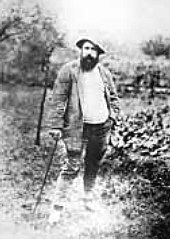(Paris 1840 - Eure 1926)
Claude Monet, French Impressionist painter. At the age of fifteen, he drew caricatures, which he exhibited in a bookstore in Le Havre, a town to which his family had moved in 1845. The painter Eugène Boudin saw those displays of the boy's artistic talent and encouraged him to dedicate himself to landscape painting.
In 1859, Monet moved to Paris and enrolled in the Swiss Academy, where he met Pissarro. He spent two years in Algeria as a soldier, and upon his return to Paris in 1862, he associated with the most important young painters of the time: Renoir, Sisley, and Bazille. In 1864, he went to Normandy, where he met Jongkind, who had a considerable influence on his work, which at that time was still quite traditional: La merienda campestre (1865), La terraza en el Havre (1866), El vestido verde (1866, Bremen Museum)…
However, although his talent was already recognized by some critics, most of his submissions to official exhibitions were systematically rejected, despite the fact that it was precisely during this time that he created his greatest works.
Indeed, at that time he abandoned the study of the figure and multiplied the luminous landscapes of Bougival and Argenteuil, in which he began to experiment with new techniques aimed at achieving a better expression of light effects.
During the war of 1870, Monet moved to Great Britain, where he reunited with Pissarro and Sisley, met Durand-Ruel, who would become his dealer, and was able to see the works of Turner and Constable, his most direct predecessors.
When he returned to France, he resumed landscape painting, painting again and again the banks of the Seine in Argenteuil, from a boat converted into a painter's studio.
Along with his former classmates from the Swiss Academy, he formed a group aimed at organizing their own exhibitions, as they were rejected from the official ones.
In 1888, he painted numerous landscapes of Antibes and began his famous series: the same subject observed over several hours of the day; thus he painted the facade of the Rouen Cathedral forty times (1892-1895), under different lights and at different times of the day.
In the last years of his life, almost blind, he painted again and again the water lilies in his garden in Giverny, and in these works, he pushed his experiences to the extreme, to the point that those color spots, almost entirely devoid of form, are considered one of the starting points of abstract art; the series of water lilies was bequeathed by Monet to the French state in 1923.
Claude Monet, French Impressionist painter. At the age of fifteen, he drew caricatures, which he exhibited in a bookstore in Le Havre, a town to which his family had moved in 1845. The painter Eugène Boudin saw those displays of the boy's artistic talent and encouraged him to dedicate himself to landscape painting.
In 1859, Monet moved to Paris and enrolled in the Swiss Academy, where he met Pissarro. He spent two years in Algeria as a soldier, and upon his return to Paris in 1862, he associated with the most important young painters of the time: Renoir, Sisley, and Bazille. In 1864, he went to Normandy, where he met Jongkind, who had a considerable influence on his work, which at that time was still quite traditional: La merienda campestre (1865), La terraza en el Havre (1866), El vestido verde (1866, Bremen Museum)…
However, although his talent was already recognized by some critics, most of his submissions to official exhibitions were systematically rejected, despite the fact that it was precisely during this time that he created his greatest works.
Indeed, at that time he abandoned the study of the figure and multiplied the luminous landscapes of Bougival and Argenteuil, in which he began to experiment with new techniques aimed at achieving a better expression of light effects.
During the war of 1870, Monet moved to Great Britain, where he reunited with Pissarro and Sisley, met Durand-Ruel, who would become his dealer, and was able to see the works of Turner and Constable, his most direct predecessors.
When he returned to France, he resumed landscape painting, painting again and again the banks of the Seine in Argenteuil, from a boat converted into a painter's studio.
Along with his former classmates from the Swiss Academy, he formed a group aimed at organizing their own exhibitions, as they were rejected from the official ones.
In 1888, he painted numerous landscapes of Antibes and began his famous series: the same subject observed over several hours of the day; thus he painted the facade of the Rouen Cathedral forty times (1892-1895), under different lights and at different times of the day.
In the last years of his life, almost blind, he painted again and again the water lilies in his garden in Giverny, and in these works, he pushed his experiences to the extreme, to the point that those color spots, almost entirely devoid of form, are considered one of the starting points of abstract art; the series of water lilies was bequeathed by Monet to the French state in 1923.


